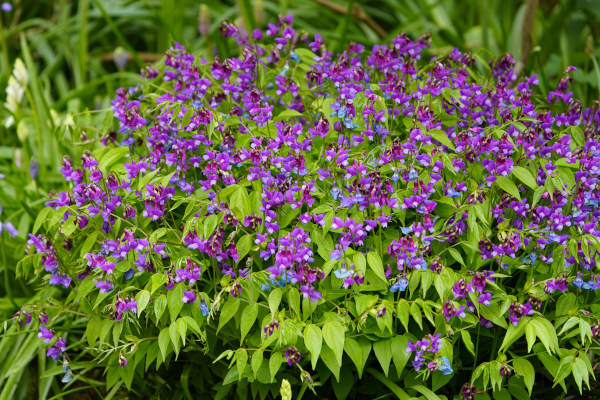How to grow Lathyrus
There are over 150 species of this member of the pea family, though only a handful are widely cultivated by gardeners. Most common is Lathyrus odoratus, the annual, climbing sweet pea grown for its colourful, scented flowers. After that it is L. latifolius and L. grandiflorus, also known as perennial or ‘everlasting’ sweet peas, which are scrambling climbers usually with unscented blooms. Occasionally, you may also encounter L. vernus, also known as spring vetchling. This is a more unusual, clump-forming perennial sweet pea which remains low and bushy, and flowers earlier in the year.
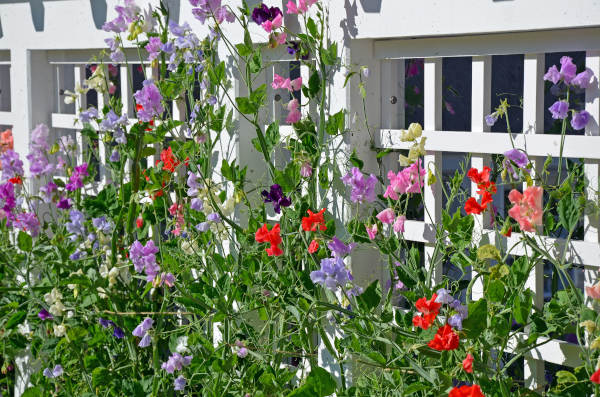
Zantedeschia is a genus of flowering plants from the family Araceae and is native to southern Africa. With a rich history dating back to the Ancient Romans, these deciduous or semi-evergreen perennials have been used as a symbol of celebration. Zantedeschia was Named after Professor Giovanni Zantedeschia, an Italian botanist.
There are two main forms of Zantedeschia: hardy and tender. Hardy forms of the plant can be grown outdoors, enjoy moist soil and full sun or partially shaded conditions - these are known as Arum lilies. Tender forms of Zantedeschia prefer being grown in containers or pots and should be brought inside over the winter - these are known as Calla lilies.
With tuberous flora in all colours from whites, yellows and oranges to deep reds and purples, Zantedeschias are not to be overlooked in any garden, as long as they have sufficient sunlight to grow in.
Ready to learn more about growing Zantedeschia? Read on for all there is to know...

Key Information
Soil pH
Position
Hardiness

Horticultural Divisions -
Species | Life cycle | Hardiness |
Lathyrus odoratus | Annual | Tender/ H3 (1°C to -5°C), or half-hardy/ H4 (-5°C to -10°C)
|
L. latifolius | Perennial | Very hardy/ H7 (-20°C and beyond)
|
L. grandiflorus | Perennial | Hardy/ H6 (-15°C to -20°C) |
L. vernus | Perennial | Hardy/ H6 (-15°C to -20°C) |
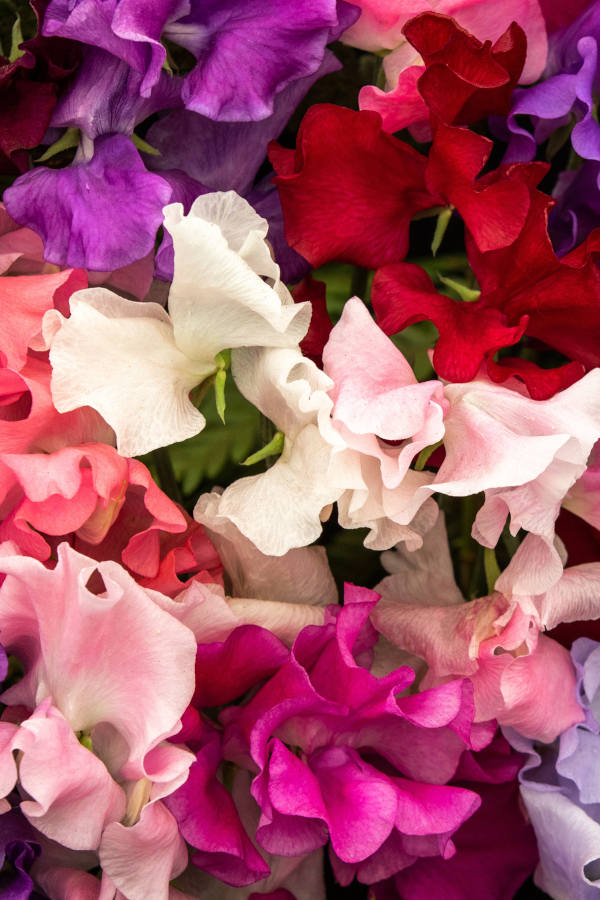
Where & when to plant Lathyrus
Position- Full sun to light, dappled shade (L. grandiflorus is the most tolerant of shade).
Soil- Fertile, humus rich, moist yet well drained. Any pH.
Avoid free-draining soil prone to drying out.
Flowering Period- Mostly summer into autumn, with the exception of L. vernus which blooms in spring.
Hardiness- Varies depending on the species. See below.
Annual species:
We send our annual sweet peas out as young plants (or plugs) from late spring, which can be planted out once all risk of frost has passed in your area. This varies from region to region, though tends to be April/ May. If your plants arrive before you feel the time is right to plant them out, pot up into 9cm pots filled with a well-draining compost and grow on in a frost-free environment such as a coldframe, unheated greenhouse, or cool windowsill.
Perennial species:
For best results, plant in autumn or spring. An autumn planting can be done by those gardening in mild conditions (and broadly speaking, this is the southern half of the UK). For those liable to cold winters, it is best to wait until spring (generally the northern half of the UK). Planting can also be carried out in summer, though be prepared to water regularly.
Lathyrus is a classic, cottage garden plant. Plant climbing species with some form of support (a wigwam, canes, or netting all work well), or allow to scramble over a bank or through a shrub. Clump-forming species will need space to bush out and are best located towards the front of a border. Lathyrus can also be grown in a large, deep container, though will require frequent watering.
How to plant Lathyrus
Annual species:
- For planting in the garden, the soil should ideally be prepared the previous autumn. Dig the soil area removing any large stones and weeds and breaking up any lumps. Mix in some organic matter such as manure or garden compost, and, if your soil is on the heavy side, now is also the time to add a generous helping of horticultural grit. Rake level and firm with your heels. Rake level again.
- When it comes to planting in late spring, water plants well and allow to drain before planting. You may also wish to pinch out the growing tip of the primary stem at this point, to encourage branching growth and therefore a greater quantity of flowers.
- Work some general purpose granular feed into the planting area.
- Install the support (wigwam, canes, netting etc.) prior to planting.
- Lay plants out close to the support, spacing 20-30cm apart. Handle gently, as the stems are easily damaged; particularly when you are removing them from their pots or root trainers.
- A good tip is to dig a hole twice the size of the root-ball. Fill with water and allow to drain.
- Place the plant in the hole, ensuring the top of the root ball sits level with the surface of the soil. Too low and the plant may rot, too high and the roots can dry out.
- Backfill with soil and firm in gently.
- Soak well with water.
- Mulch around the base with well-rotted organic matter.
- As growth progresses, tie in stems using garden twine as and when necessary. Tendrils growing close to the support naturally cling on, but those further away will need a little help.
- For planting in containers, first choose a large, deep pot. Always ensure there are plenty of drainage holes in the bottom.
- Water plants well and allow to drain before planting. You may also wish to pinch out the growing tip of the primary stem at this point, to encourage branching growth and a greater quantity of flowers.
- It can be a good idea to fill and plant large pots in situ to save yourself the trouble of moving once full.
- Use a good quality potting compost with a little horticultural grit mixed in, and, if not already present in the compost (check the description on the bag) some slow-release fertiliser granules.
- Start by filling the pot with compost, leaving a gap of around 3cm below the top rim.
- Pick up the container and lightly tap on the potting bench or ground a few times to help settle the compost.
- Insert canes, pea sticks, or netting for support.
- Plant the lathyrus close to the supports, aiming for a spacing of around 10cm between plants.
- Soak well with water.
- A mulch with horticultural grit will look attractive and help to prevent a ‘cap’ or crust forming on the top of the compost (something container plants can suffer due to the artificial nature of their watering).
- As growth progresses, tie stems into the supports on a regular basis. Tendrils growing close to the support naturally cling on, but those further away will need a little help.
- ‘Stop’ growth when it reaches the top of the support, i.e., snip back to the desired height.
Perennial species
- For planting in the garden, dig the soil area removing weeds and breaking up any lumps. If your soil is on the heavy side, now is the time to add a generous helping of horticultural grit. Rake level and firm with your heels. Rake level again.
- Water plants well and allow to drain before planting.
- For climbing species, install the support (if using) prior to planting. Alternatively, these can be allowed to scramble through shrubs or over banks and walls.
- A good tip is to dig a hole twice the size of the root-ball. Fill with water and allow to drain before placing in the plant.
- Place the plant in the hole, ensuring the top of the root ball sits level with the surface of the soil. Too low and the plant may rot, too high and the roots can dry out.
- Backfill with soil and firm in gently with your foot.
- Soak well with water.
- Mulch around the base with well-rotted organic matter.
- As growth progresses, tie stems into the supports (if using) on a regular basis. Tendrils growing close to the support naturally cling on, but those further away will need a little help.
- For planting in containers, first choose an appropriately sized pot. The best practice is to start just a few centimetres larger than the rootball and increase in size every year or two. Always ensure there are plenty of drainage holes in the bottom.
- If you are using a large or heavy pot, it can be a good idea to fill and plant it in situ to save yourself the trouble of moving once full.
- Use a good quality potting compost with a little horticultural grit mixed in, and, if not already present in the compost (check the description on the bag) some slow-release fertiliser granules.
- Start by partially filling the pot with compost; enough so that when placed on it the upper surface of the root ball is about 3cm lower than the top of the pot.
- Infill all the space surrounding the root ball with compost, firming down with your fingers then adding a little more so the plant is held tight.
- Pick up the container and lightly tap on the potting bench or ground a few times to help further settle the compost around the plant.
- For climbing species, insert canes or a permanent metal support.
- Soak well with water.
- A mulch with horticultural grit will look attractive and help to prevent a ‘cap’ or crust forming on the top of the compost (something container plants can suffer due to the artificial nature of their watering).
- For climbing species, tie stems into the supports on a regular basis. Tendrils growing close to the support naturally cling on, but those further away will need a little help.
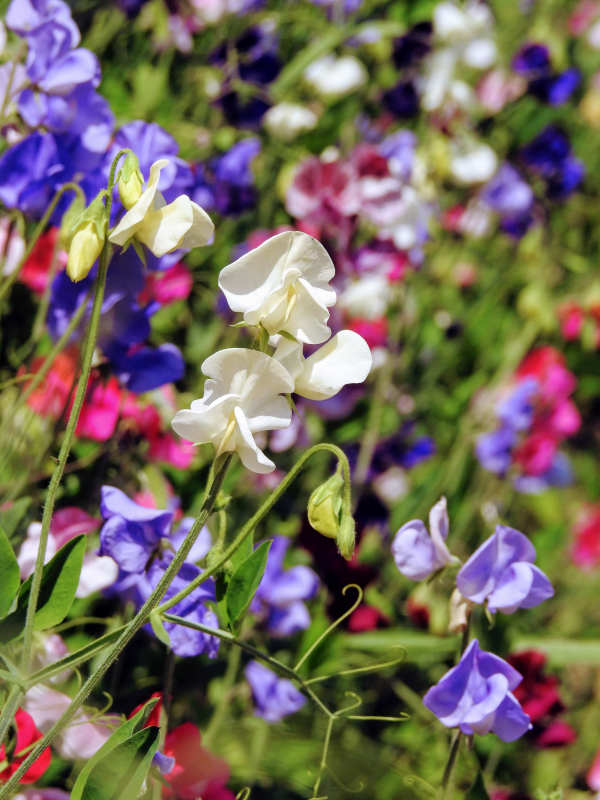
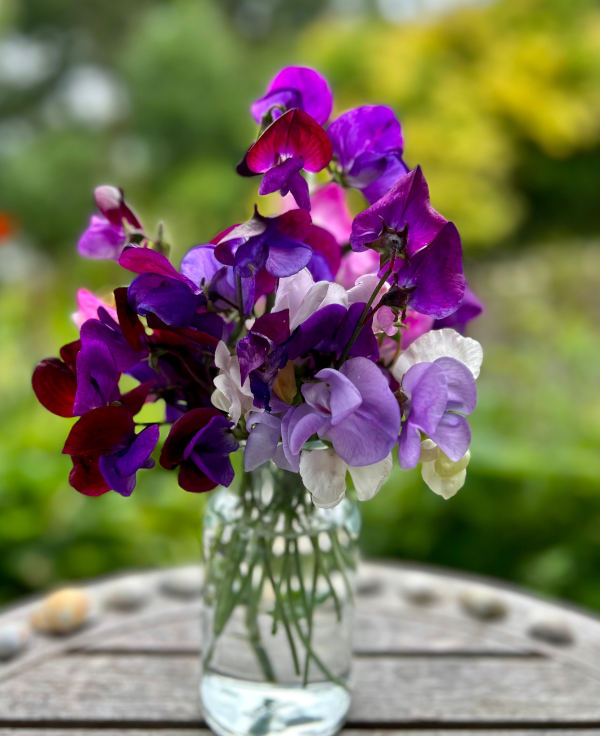
How to care for Lathyrus
Pruning and Deadheading
Pinching out the growing tip of the primary stem when planting in spring can be an effective way of encouraging bushy, floriferous growth.
After this, frequent deadheading is important for prolonging the flowering period (particularly with annual species), as they will cease blooming if seed pods are allowed to develop. Try to get in a weekly habit of removing any flowers looking past their prime. Picking young flowers for indoors is another way of encouraging further blooms.
Annual species can simply be removed to the compost heap once they have finished flowering in late summer or early autumn. Perennial species can be cut back to ground level anytime from autumn to early spring.
Watering
Give your sweet peas a good soaking on planting. After this it is important to keep these naturally thirsty plants watered regularly, as they will struggle to flower well if allowed to dry out. Aim for consistently moist, but not soggy soil.
Container-grown lathyrus require a significant amount of watering during the growing season. The National Sweet Pea Society recommend watering every day there isn’t rain. If plants are fully grown, they may even need watering on rainy days, as their mass of stems and foliage can deflect rainwater away from the roots.
Feeding
On healthy, fertile soils, as long as the ground has been prepared as in our ‘How to plant lathyrus’ section above, a mulch of well-rotted organic matter on planting should provide sufficient nutrients. This means a layer of manure or garden compost applied around the plant, with the added bonus of suppressing weeds and locking in moisture.
On lighter, poorer soils, you may find an additional weekly dose of liquid tomato feed helps boost flowering.
Container-grown plants will benefit from regular feeding. Get off to a flying start by making sure you use a good quality compost, then throughout the growing season apply a liquid tomato feed at weekly intervals.
Cold Protection
Perennial species of lathyrus are hardy enough to withstand a UK winter without the need for additional protection.
Annual species are more tender, so should only be planted out once all risk of frost has passed. They will naturally die back at the end of the growing season.
Pests and Diseases
Lathyrus tends to be problem-free aside from the potential for powdery mildew (a fungal disease). This appears as a white, powder-like coating on foliage, and can be caused by poor air flow, drought stress, or insufficient sunlight.
Prune off and dispose of any affected leaves, keep plants well-watered (avoiding water on the foliage if possible), and if necessary, thin out surrounding plants to improve airflow. Do not over fertilise, as this will generate an excess of soft, new growth which is particularly susceptible.
Aphids can also be partial to the sap of sweet peas. While unsightly, these are part of a balanced garden ecosystem, and the best approach is to leave them to their natural predators (e.g. birds, ladybirds, wasps, frogs). When numbers are so large, however, that their feeding starts to inhibit and disfigure growth, you may feel it necessary to take action. Regularly blasting off with a hose or wiping away with a cloth or piece of kitchen paper can help to keep numbers down without harming beneficial organisms.
How to propagate Lathyrus
Perennial species
Large, established clumps can be divided in autumn or spring. Autumn is recommended if you are somewhere mild (generally from the Midlands down). For those liable to cold winters (i.e., the north), it is best to wait until spring. Wait until after flowering if dividing L. vernus in spring.
- Choose a day when the soil is not frozen or waterlogged.
- Dig the plant out of the ground.
- Shake off any excess soil.
- Separate the plant into sections using either swift, cutting blows with a sharp spade, or two forks inserted back-to-back with tines touching, handles then pushed together to prise the plant apart.
- Discard old, damaged, or surplus pieces, keeping healthy, vigorous material.
- Replant selected pieces where desired.
- Water well until fully established.
Annual species
These are easily propagated by seed, which should be collected from plants when ripe and sown in pots in autumn or early spring. Whichever time of year you sow, the young plants should be planted out in late spring once all risk of frost has passed.
n.b., Lathyrus resents having its roots disturbed, so seed should be sown individually in deep containers. Recommended are 9cm pots, root trainers, or the inner cardboard tubes from toilet rolls packed upright in a tray.
- Seeds are typically ready for collecting in late summer to early autumn. You will know they are ripe when the pod is brown and dry and the seeds inside are black.
- Snip the seedheads from the plant using scissors or secateurs. Try to do this in dry conditions.
- Separate the seeds into a small paper bag or envelope, seal, label, and store somewhere cool and dry until you are ready to sow them in either autumn or early spring.
- When the time comes, fill your containers (see above for suggestions) with well-draining compost.
- Sow seeds 1cm deep, one per container.
- Water the soil gently with a fine spray until it is evenly moist but not waterlogged.
- Keep in a frost-free environment such as a greenhouse, coldframe, conservatory, or porch until late spring.
- Check periodically to ensure the soil remains evenly moist but not waterlogged.
- Young plants will need a period of hardening off before planting out. This means moving them outside during the day for 10-14 days prior to planting.
- Plant out once all risk of frost has passed, following our ‘How to plant lathyrus’ guide above.
* Many plants carry Plant Breeders Rights and cannot be propagated for commercial purposes.
Common Lathyrus questions
Is lathyrus a hardy annual?
The popular odoratus is a half-hardy annual, meaning it should only go outside once risk of frost has passed.
Perennial species such as L. latifolius and L. grandifloras are hardy.
What month do you plant sweet peas?
Plant out young plants of annual species in late spring once you are confident temperatures will remain above 0°C. This can be April in milder regions, or May in colder parts of the country.
Perennial species can be planted anytime, though autumn or spring give best results.
